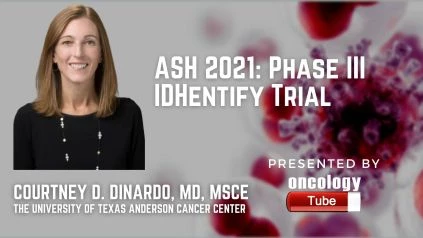Courtney D. DiNardo, MD, MSCE, is a clinical researcher who focuses on prognostication and customized treatments for myeloid malignancies patients at The University of Texas Anderson Cancer Center. Speaks about the ASH 2021 Abstract – 1243 Outcomes for Patients with Late-Stage Mutant-IDH2 (mIDH2) Relapsed/Refractory Acute Myeloid Leukemia (R/R AML) Treated with Enasidenib Vs Other Lower-Intensity Therapies in the Randomized, Phase 3 IDHentify Trial.
Link to Abstract:
https://ash.confex.com/ash/2021/webprogram/Paper147593.html
Background:
For older patients (pts) with R/R AML, the prognosis is poor, especially if numerous lines of AML treatment (Tx) have failed. After each Tx failure, achieving a response becomes increasingly difficult, and many patients are unable to endure high-intensity salvage chemotherapy regimens. IDH2 mutations are seen in 8-19% of AML patients. ENA is an IDH2 inhibitor that has been approved for the treatment of adult patients with mIDH2 R/R AML. In the phase 3, randomized IDHentify trial, older patients with late-stage mIDH2 R/R AML who had received multiple prior AML Tx were compared to ENA monotherapy vs. conventional care regimens (CCR)—intermediate-dose cytarabine (IDAC), low-dose cytarabine (LDAC), azacitidine (AZA), or best supportive care (BSC) only. Clinical outcomes for IDHentify patients who were preselected to one of the lower-intensity CCR options (LDAC, AZA, or BSC alone) before being randomly assigned to ENA or CCR are presented below.
Methods: Patients aged 60 years and older with ECOG PS 2 and mIDH2 AML R/R to 2–3 previous AML Tx were enrolled in this multinational, multicenter, open-label investigation. Pts were pre-selected for AZA 75 mg/m2/day (d) 7d, IDAC 0.5–1.5 g/m2 3–6d, LDAC 20 mg BID 10d, or BSC alone before randomization. Pts were then randomly assigned to receive either ENA (100 mg QD) or CCR in 28-day Tx cycles; those who were assigned to CCR got their pre-selected Tx. BSC could be awarded to all points. Pts preselected to lower-intensity AZA, LDAC, or BSC alone are included in these post hoc analyses.
Overall response rate (ORR: complete remission [CR], complete remission with incomplete recovery [CRi/CRp], partial response [PR], or morphologic leukemia-free state [MLFS], per IWG 2003 AML response criteria), rates of hematologic improvement (HI) and transfusion independence (TI) (per IWG 2006 MDS criteria), overall survival (OS), event-free survival (EFS), and time to Tx failure were among the endpoints (TTF). OS was measured in the ITT group as well as among efficacy-evaluable (E-E) patients who received one study medication dosage and had one response evaluation on-Tx.
Results:
In all, 267 (84%) of the 319 recruited patients were preselected for a lower-intensity Tx regimen before being randomized 1:1 to receive ENA (n = 139) or their preselected CCR (n = 128: AZA 69, LDAC 37, BSC 22). At the time of the data cutoff (17 March 2020), 10 ENA points and 4 CCR points were still receiving their assigned Tx. The ENA arm had a median Tx duration of 143 days (range 3–1270) and the CCR arm had a median Tx duration of 49 days (1–1166); 15 CCR pts (12%) and 1 ENA pt stopped before receiving allocated Tx. Following the discontinuation of Tx, 43 ENA pts (31%) and 52 CCR pts (41%) received further AML Tx, with 12 CCR pts (9%) receiving commercially available ENA. The baseline (BL) features of the Tx arms were remarkably identical. Overall, the median age was 72 years old (range 60–86 years old), and 80 percent of patients had received two prior AML treatments, 61 percent had ELN adverse-risk AML, 41 percent had primary refractory AML (ie, never achieved CR/CRi/CRp), and 63 percent and 51 percent of patients were RBC and platelet transfusion-dependent (TD).
ORR was significantly higher with ENA vs CCR (41 percent vs 11 percent, respectively) among all pts preselected to a lower-intensity Tx (ITT), as were rates of CR (26 percent vs 3 percent) and HI (41 percent vs 13 percent) (P 0.001, all comparisons) (Table), and proportionally more pts in the ENA arm achieved or sustained RBC and platelet TI (Table). With ENA vs CCR, OS was prolonged (HR 0.74 [95 percent CI 0.56, 0.97]; P = 0.029), with a late separation of the curves after median OS had been attained (median OS 6.8 vs 6.2 mo, respectively), and 1-year survival rates were 41 percent vs 26 percent (15.0 percent [3.4 percent, 26.6 percent]). OS was enhanced with ENA (HR 0.70 [0.53, 0.93]; P = 0.013) in E-E pts (ENA, n = 133; CCR, n = 110): median OS was 6.9 months vs 5.7 months with CCR. With ENA vs CCR, EFS and TTF in the ITT population were also extended (Table).
The safety of ENA was identical in this pt subgroup to that of all ENA-randomized pts, which was in line with prior findings (Stein 2019). ENA-related differentiation syndrome was seen in 13% of patients, and hyperbilirubinemia was seen in 26%.
Conclusions:
When compared to conventional lower-intensity Tx alternatives, ENA was linked with clinically relevant improvements in morphologic response, HI, RBC and platelet TI, and survival in patients with late-stage mIDH2 R/R AML. The large proportion of pts randomized to CCR who did not get Tx or quit Tx early, as well as the considerable usage of later Tx (including ENA) during follow-up, may have influenced OS outcomes. These clinical advantages suggest the use of ENA as an appropriate oral outpatient therapy for patients with mIDH2 R/R AML who are not candidates for intensive treatments.

